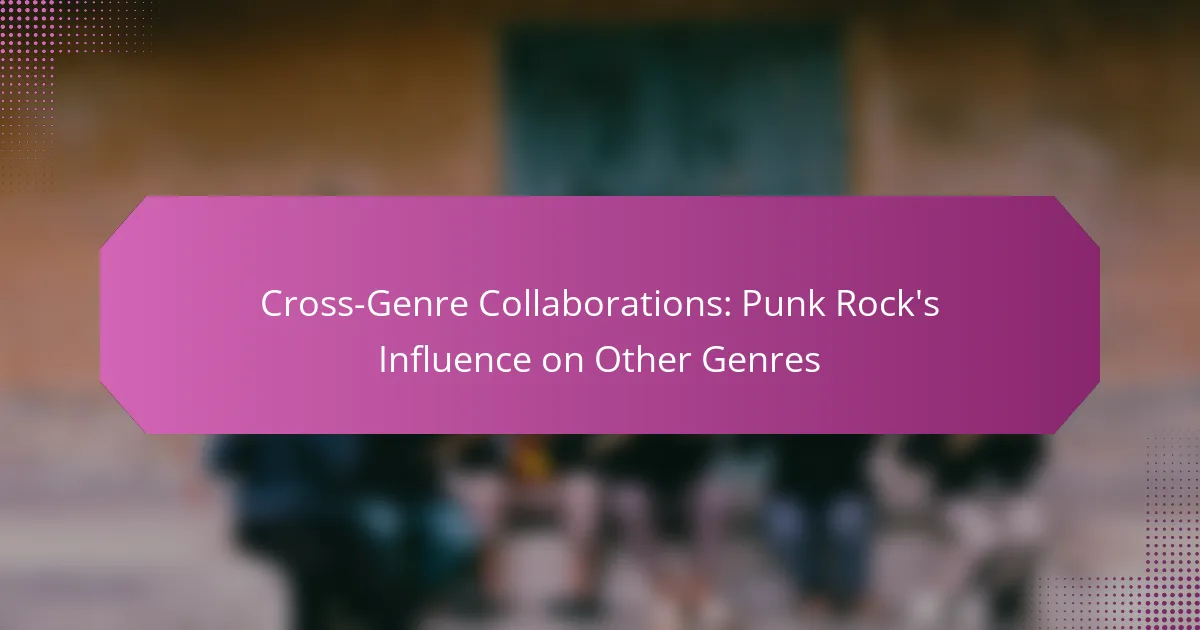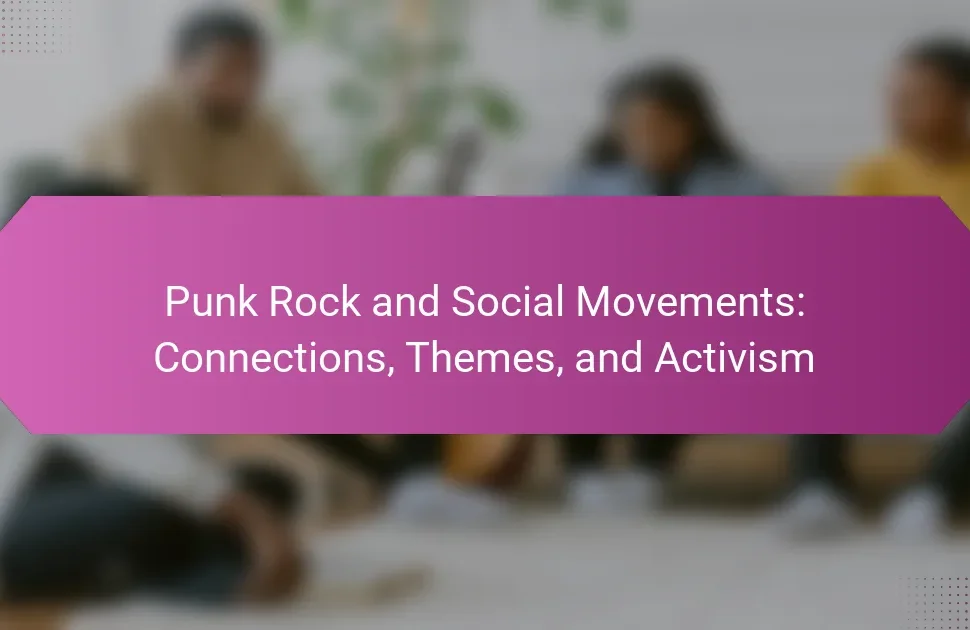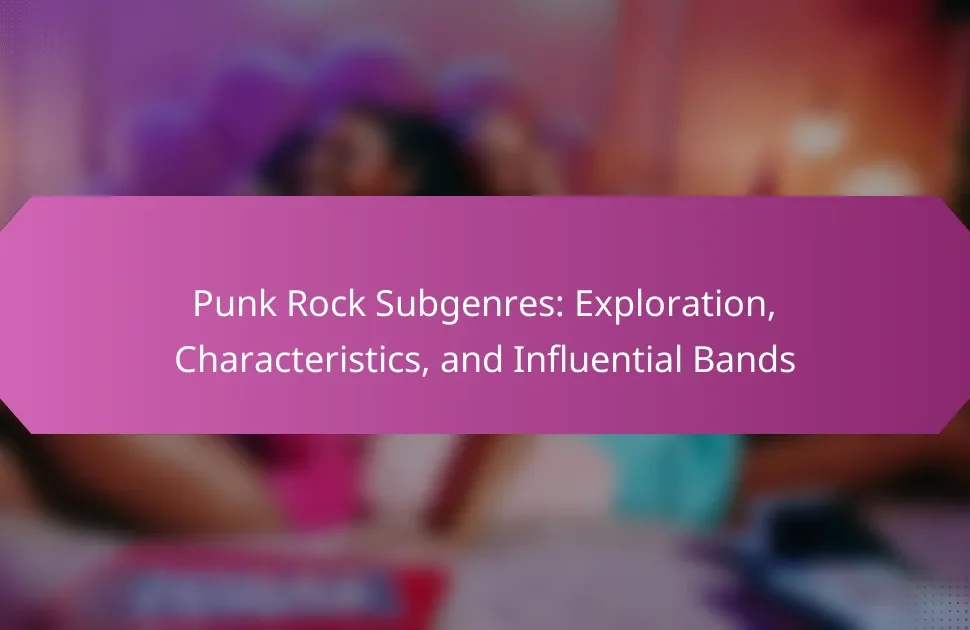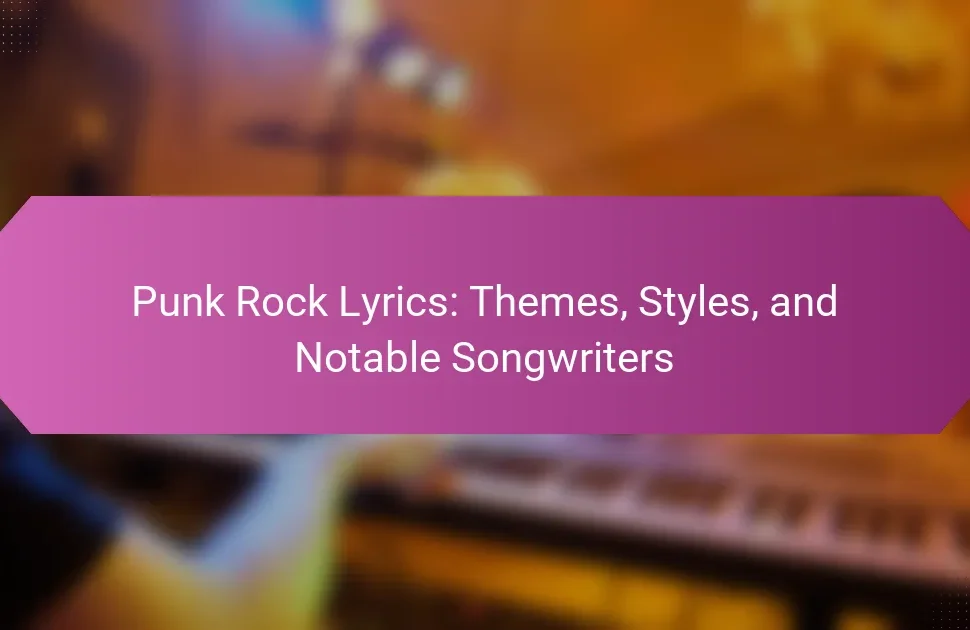Punk rock’s influence extends beyond its own genre, shaping mainstream music in significant ways. It has impacted pop punk and alternative rock, promoting innovation and diversity. Collaborations with hip-hop and electronic artists showcase its versatility. However, some genres resist these influences due to their established traditions.
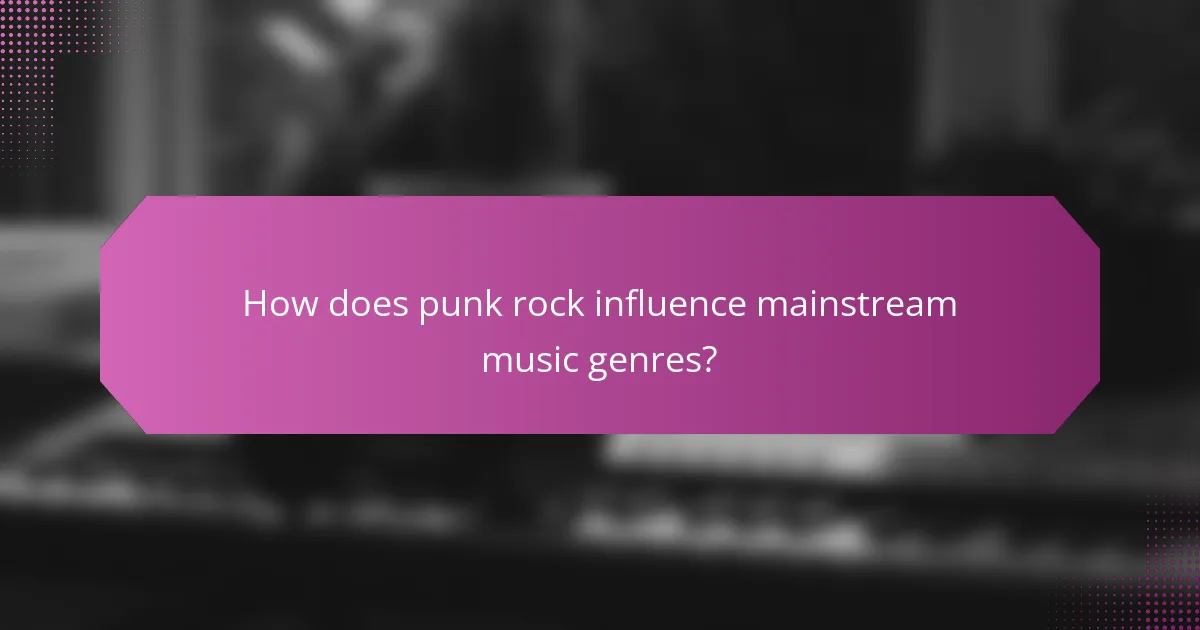
How does punk rock influence mainstream music genres?
Punk rock significantly influences mainstream music genres through its distinct sound and ethos. Its emphasis on raw energy and rebellion has shaped various styles, including pop punk, alternative rock, and even hip-hop.
For instance, pop punk bands like Green Day and Blink-182 have integrated punk’s fast tempos and catchy melodies into mainstream pop music. This fusion has led to a broader acceptance of punk elements in popular culture.
Moreover, punk rock’s DIY ethic has inspired artists across genres to pursue independent production methods, enhancing creativity and authenticity in music. Collaborations between punk and hip-hop artists, such as collaborations with artists like Machine Gun Kelly, showcase punk’s versatility and enduring appeal.
Overall, punk rock’s influence is evident in the evolution of mainstream music, promoting innovation and diversity across genres.
What are the key characteristics of punk rock that resonate with other genres?
Punk rock’s key characteristics resonate with other genres through its raw energy, rebellious spirit, and DIY ethos. These traits inspire various musical styles, creating cross-genre collaborations. Punk rock’s simplicity and directness influence pop, metal, and hip-hop, encouraging artists to embrace authenticity. Its themes of social critique and personal expression resonate across genres, fostering a sense of unity among diverse musical communities.
Which contemporary artists exemplify punk rock’s influence across genres?
Contemporary artists like Billie Eilish, Machine Gun Kelly, and Yungblud exemplify punk rock’s influence across genres. Their music incorporates punk elements, blending them with pop, hip-hop, and alternative rock. For example, Billie Eilish’s raw lyrics and rebellious themes resonate with punk ethos. Machine Gun Kelly’s transition from rap to pop-punk showcases genre fluidity. Yungblud’s energetic performances and defiance of norms reflect punk’s spirit in modern music. These artists illustrate punk rock’s enduring impact on diverse musical landscapes.
How do punk rock elements enhance the appeal of pop music?
Punk rock elements enhance the appeal of pop music by infusing energy, authenticity, and rebellious spirit. These attributes attract diverse audiences and create a dynamic sound. The rawness of punk adds emotional depth, while catchy hooks from pop maintain accessibility. Collaborations often lead to innovative fusions, broadening the appeal of both genres. For example, artists like Billie Eilish incorporate punk influences, resulting in chart-topping hits that resonate with younger listeners. This cross-genre synergy revitalizes pop music, making it more relatable and engaging.
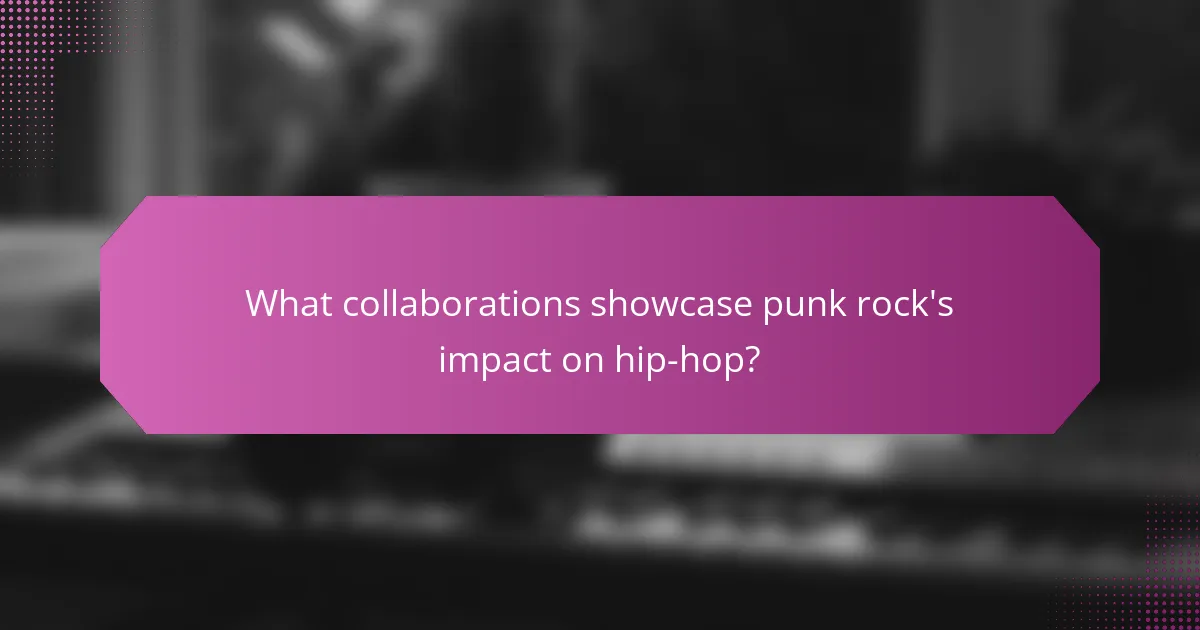
What collaborations showcase punk rock’s impact on hip-hop?
Collaborations like Run-D.M.C. featuring Aerosmith in “Walk This Way” exemplify punk rock’s influence on hip-hop. Other notable partnerships include Beastie Boys with punk legends and Lil Wayne’s nods to punk aesthetics. These collaborations blend aggressive styles, showcasing punk’s rebellious spirit in hip-hop culture.
How have punk rock artists collaborated with hip-hop musicians?
Punk rock artists have collaborated with hip-hop musicians to create innovative sounds and broaden audience appeal. Notable collaborations include the fusion of punk’s raw energy with hip-hop’s rhythmic complexity. This cross-genre synergy has led to memorable tracks, such as the collaboration between the band Rancid and rapper KRS-One. These partnerships often highlight shared themes of rebellion and social commentary, enhancing the cultural impact of both genres. The unique blending of styles showcases the versatility of musicians and the evolving landscape of modern music.
What are the notable outcomes of punk and hip-hop collaborations?
Punk and hip-hop collaborations often yield innovative sounds and cultural exchanges. These partnerships challenge genre boundaries and create new audiences. Notable outcomes include cross-pollination of lyrical themes, blending of musical styles, and increased visibility for both genres. Collaborations can also lead to unique artistic expressions, as seen in tracks that mix punk’s raw energy with hip-hop’s rhythmic complexity.
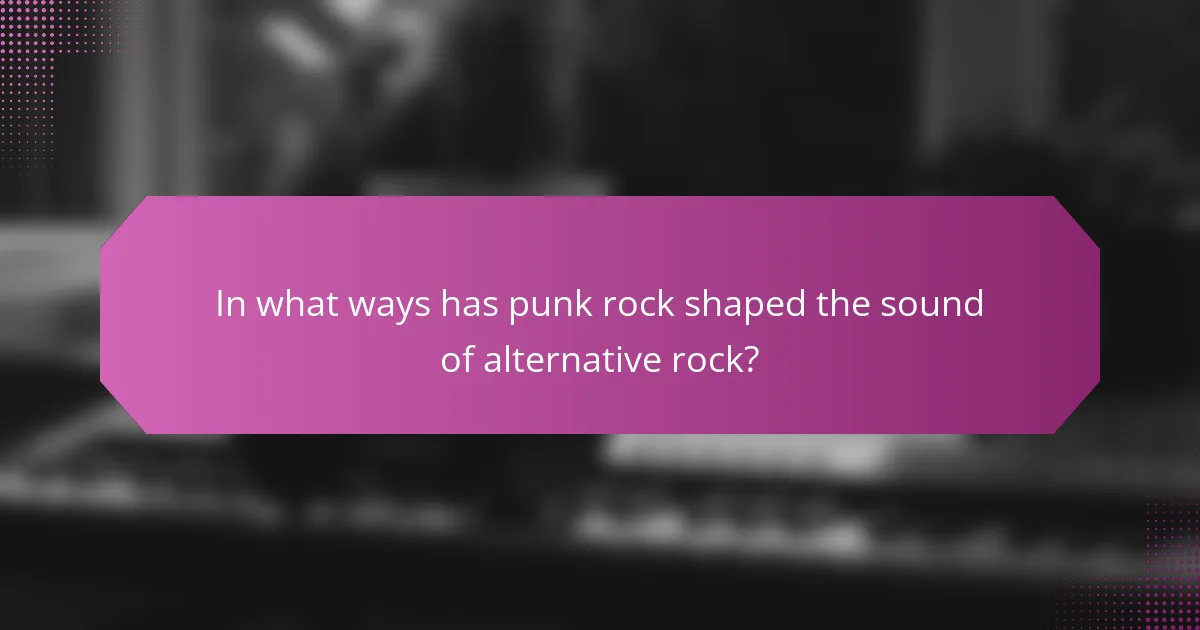
In what ways has punk rock shaped the sound of alternative rock?
Punk rock has profoundly influenced alternative rock through its raw energy and DIY ethos. This genre introduced a faster tempo and aggressive sound that alternative rock adopted, shaping its identity. Punk’s emphasis on authenticity and rebellion resonated with alternative artists, encouraging experimentation and genre-blending. For example, bands like Nirvana and Green Day incorporated punk elements, leading to a fusion that defined 1990s alternative rock. The legacy of punk rock continues to inspire new generations, ensuring its sound remains integral to the evolution of alternative music.
Which alternative rock bands have been significantly influenced by punk rock?
Several alternative rock bands have been significantly influenced by punk rock, including Green Day, The Offspring, and Blink-182. These bands incorporate punk’s raw energy and ethos into their sound. Green Day’s album “Dookie” exemplifies this blend, showcasing fast tempos and rebellious themes. The Offspring’s “Smash” further popularized the punk sound in the 90s with catchy melodies and socially charged lyrics. Blink-182’s upbeat style and humorous lyrics also reflect punk’s influence, especially in their early work.
How do punk rock themes manifest in alternative rock lyrics?
Punk rock themes manifest in alternative rock lyrics through rebellion, authenticity, and social commentary. These elements often reflect dissatisfaction with societal norms. For example, the raw energy in punk influences alternative rock’s emotional expression. The themes of individualism and anti-establishment sentiments are prevalent, showcasing a unique attribute of punk’s impact. Additionally, the incorporation of fast tempos and aggressive guitar riffs creates a distinct sound that resonates across genres.
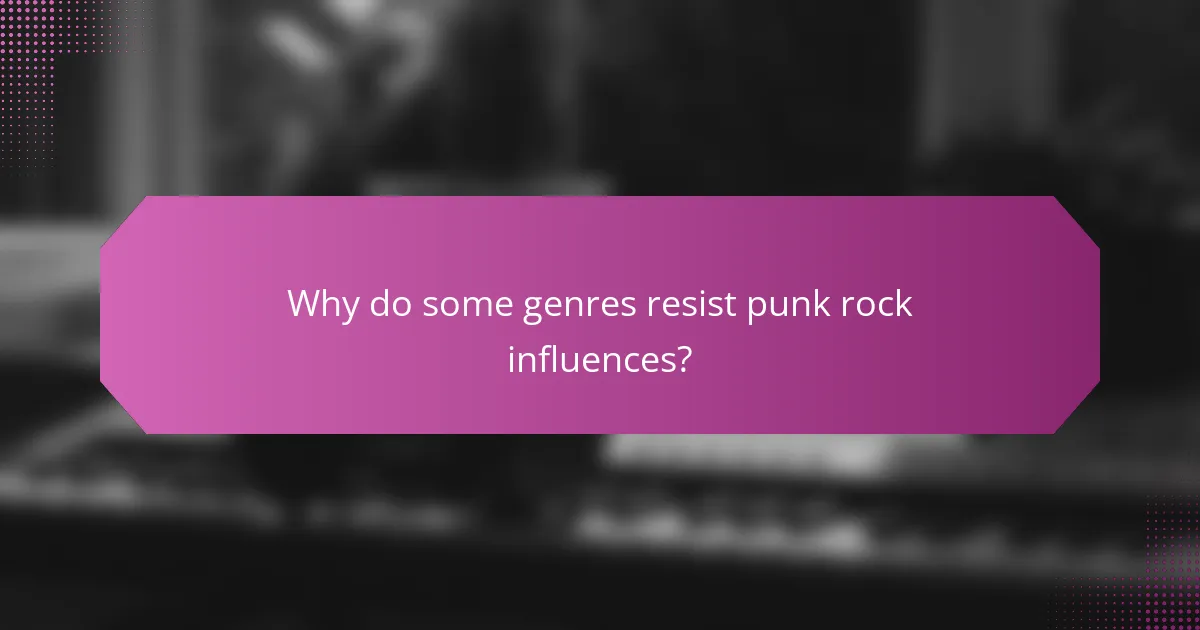
Why do some genres resist punk rock influences?
Some genres resist punk rock influences due to their established traditions and differing musical values. Genres like classical and jazz prioritize complexity and technical proficiency, contrasting with punk’s raw simplicity and rebellion. Additionally, cultural contexts shape genre identities, making adaptation to punk influences less appealing. The unique attributes of these genres contribute to their resistance, maintaining distinct musical legacies.
What characteristics prevent certain genres from blending with punk rock?
Certain genres struggle to blend with punk rock due to their contrasting characteristics. Genres like classical or jazz often prioritize technical proficiency and complex arrangements, which clash with punk’s raw simplicity and emphasis on energy. Additionally, the thematic content of punk, often rooted in rebellion and anti-establishment sentiments, can conflict with the more commercial or polished nature of pop music. These fundamental differences in musical structure, lyrical themes, and cultural values create barriers to effective cross-genre collaborations.
How do cultural perceptions of punk rock affect its reception in various genres?
Cultural perceptions of punk rock significantly influence its reception across various genres. Punk rock’s rebellious ethos resonates differently in genres like pop, metal, and hip-hop, affecting collaboration dynamics.
For instance, pop artists often adopt punk elements to project an edgy image, while metal bands may integrate punk’s raw energy to enhance their sound. This blending creates unique sub-genres, such as pop-punk, which reflects punk’s cultural roots while appealing to broader audiences.
Moreover, the DIY ethos of punk inspires independent artists across genres, fostering a sense of community and collaboration. This cultural aspect encourages diverse musical experimentation, leading to innovative cross-genre collaborations that challenge traditional boundaries.
Overall, punk rock’s cultural significance shapes its reception and influences the creative processes within various music genres.
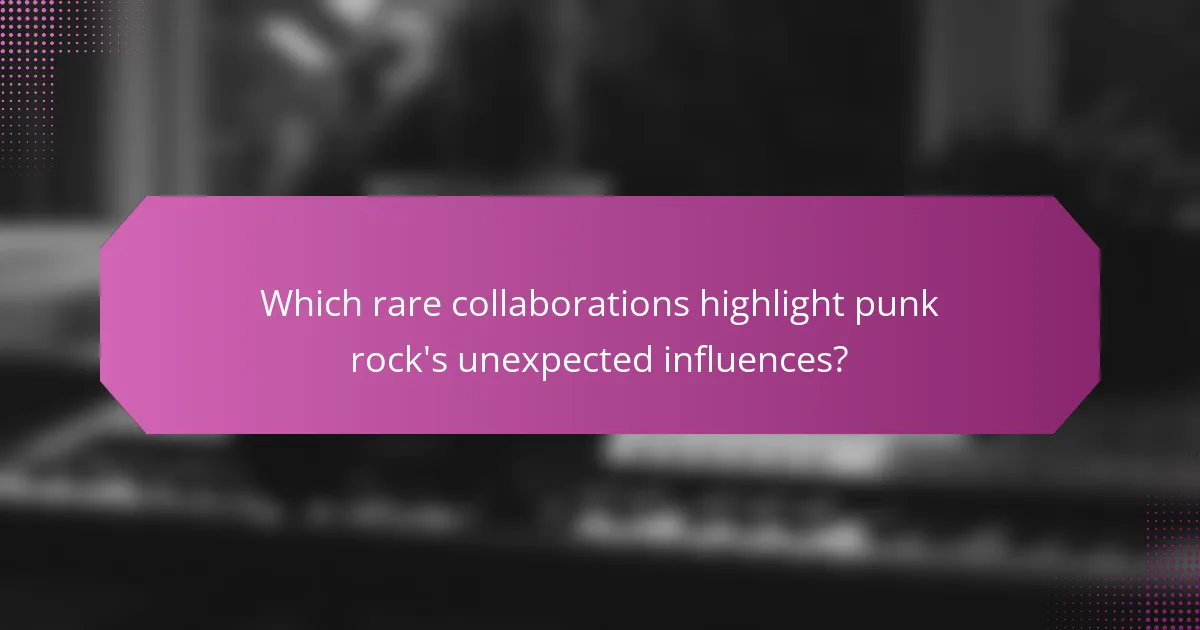
Which rare collaborations highlight punk rock’s unexpected influences?
Punk rock’s unexpected influences are showcased in rare collaborations with artists from various genres. Notable examples include the collaboration between punk band The Offspring and pop singer Carly Rae Jepsen, which merged punk energy with pop sensibility. Another significant instance is the partnership of punk icon Iggy Pop with electronic artist Peaches, blending punk’s rawness with electronic beats. Additionally, the collaboration between punk band Rancid and reggae legend Jimmy Cliff highlights the fusion of punk rock with reggae rhythms. These collaborations illustrate punk rock’s versatility and its ability to transcend genre boundaries.
What unique projects feature punk rock artists in non-traditional genres?
Punk rock artists frequently collaborate across genres, creating unique projects that blend styles. Notable examples include punk-infused pop albums and collaborations with electronic music producers. These projects often showcase punk’s raw energy in unexpected contexts, such as hip-hop tracks featuring punk vocalists. The fusion of punk’s rebellious spirit with other genres expands its influence and reach.
How have cross-genre collaborations evolved over the decades?
Cross-genre collaborations have evolved significantly, showcasing punk rock’s influence across various music styles. Initially, punk rock was a reaction against mainstream music, but over the decades, it integrated with genres like pop, hip-hop, and electronic music.
In the 1980s, bands like The Clash fused punk with reggae and ska, broadening their appeal. The 1990s saw collaborations with hip-hop artists, exemplified by groups like Rancid. In the 2000s, punk’s raw energy influenced pop-punk and emo, with artists like Green Day achieving mainstream success.
Today, punk rock continues to inspire a diverse range of artists, blending with indie, metal, and even country. This evolution highlights punk’s adaptability and lasting impact on the music landscape.
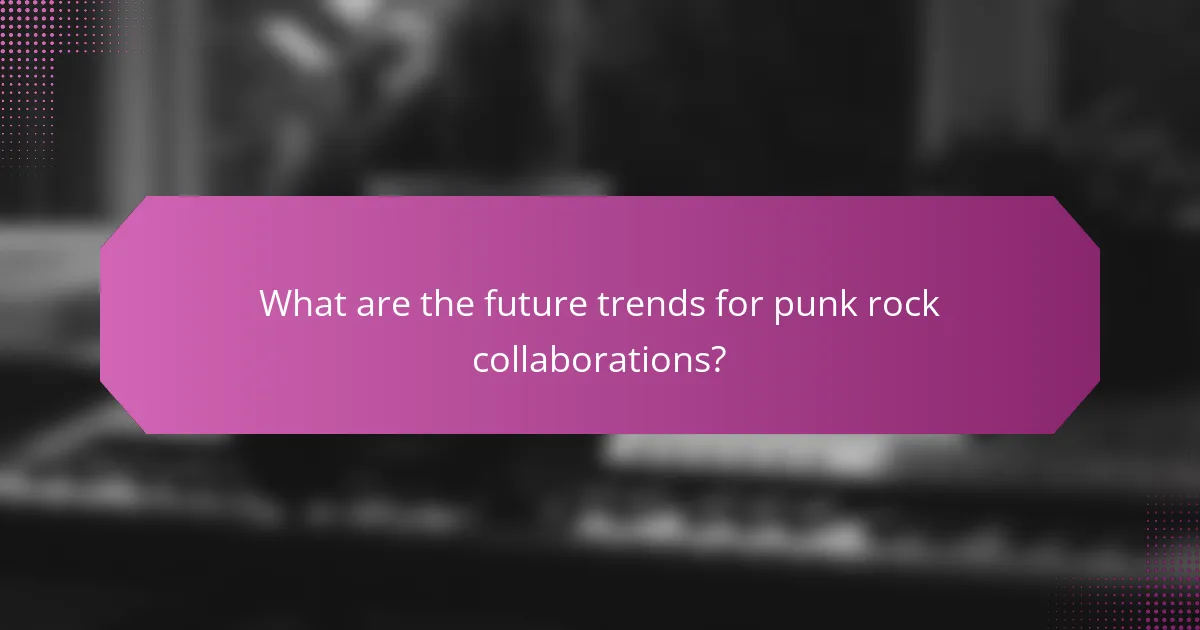
What are the future trends for punk rock collaborations?
Punk rock collaborations will increasingly blend with genres like hip-hop, electronic, and pop. This trend reflects punk’s adaptability and influence, leading to innovative sounds. Collaborations may feature punk artists integrating diverse musical elements, enhancing their reach. As a result, expect unique fusions that challenge traditional genre boundaries.
How are emerging artists integrating punk rock into their music?
Emerging artists are integrating punk rock into their music by blending its raw energy with diverse genres. This fusion creates innovative sounds that resonate with a wider audience. Collaborations with hip-hop, pop, and electronic music are particularly notable. For instance, artists like Machine Gun Kelly and Billie Eilish have incorporated punk elements into their works, revitalizing the genre. This cross-genre approach not only pays homage to punk’s rebellious spirit but also introduces it to new listeners, ensuring its evolution and relevance in contemporary music.
What strategies can artists use to successfully collaborate across genres?
Artists can successfully collaborate across genres by embracing experimentation, communication, and mutual respect. Establishing a clear vision is essential for blending punk rock’s raw energy with elements from other genres.
Building relationships with artists from different styles fosters creativity. For instance, punk rock’s influence on pop or hip-hop can lead to innovative soundscapes. Collaborators should remain open to diverse ideas, allowing for fresh interpretations and unique sounds.
Setting common goals helps maintain focus during the collaboration process. Artists can benefit from sharing their influences and inspirations, which enriches the creative dialogue. Regular feedback ensures that all voices are heard, enhancing the final product.
Lastly, promoting the collaboration through social media and live performances can engage fans from both genres. This cross-pollination not only broadens the audience but also highlights the versatility of punk rock in contemporary music.
What common mistakes should artists avoid in cross-genre collaborations?
Artists should avoid common mistakes like lack of communication, ignoring genre nuances, and failing to define roles. These pitfalls can hinder creativity and collaboration.
First, clear communication is essential for aligning artistic visions. Misunderstandings can lead to frustration and conflict. Second, artists must respect the unique attributes of each genre. Overlooking these can dilute the authenticity of the collaboration. Lastly, clearly defined roles prevent confusion. When responsibilities are ambiguous, the project may suffer from disorganization.
By addressing these mistakes, artists can enhance their cross-genre collaborations and create innovative music that blends influences effectively.
